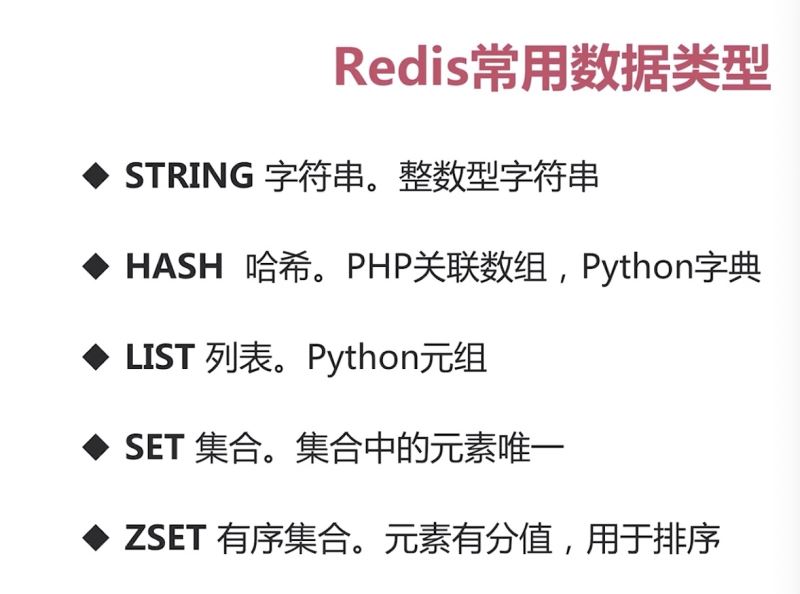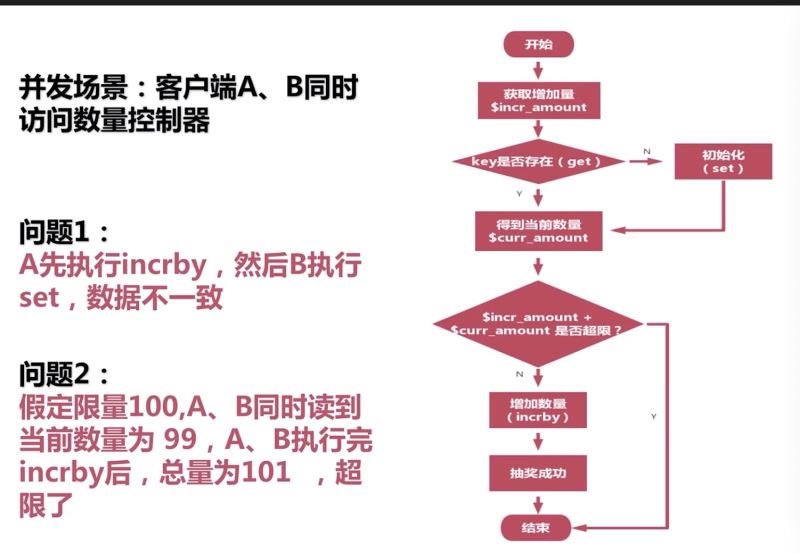How does redis solve inventory concurrency issues and achieve quantity control?
Redis is a single process and blocking type. It can only process one request at the same time, and subsequent requests need to be queued and waited.
Advantages: Because it is a single process, there is no need to deal with concurrency issues, reducing system complexity
Disadvantages: Not suitable for caching large-size objects (more than 100kb)
Reason: Due to Redis only uses a single core, while Memcached can use multiple cores, so on average Redis has higher performance than Memcached when storing small data on each core.
For data of more than 100k, the performance of Memcached is higher than that of Redis. Although Redis has also optimized the performance of storing big data, it is still slightly inferior to Memcached.
memcache is multi-process and non-blocking. If it is only used as a cache, memcache is more suitable.

1. Command
exists Check whether the key key already exists in redis, for example exists mycounter
set Set initialize a key value such as set mycounter 99
get Get a key value such as getmycounter
incr increases by 1, for example incrmycounter //The output result is 100
incrby specifies the increase value, for example incrbymycounter 2 //The output result is 102
specifies the decrease value, for example incrbymycounter -2 //The output result is 100
setnx When the value does not exist, the value is set successfully. For example, setnxmycounter 99 //The output result is 0, which means the setting failed and already exists in redis.
setnx key1 12 //The output result is 1 , indicating that the setting is successful and has not existed in redis before.
expire Set the life cycle of a key, such as expire mycounter 30 //Set to 30 seconds validity period
ttl Get the key expiration time, such as ttlmycounter //Output It is 13, which means there are 13 seconds left. If it returns -1, it means it will never expire and will always exist in the redis cache, unless there is insufficient memory.
//If it returns -2, it means it has expired and redis has no such The key value can be verified with exists, and 0 is returned, which means it does not exist
2. Common scenarios
Due to the rush to buy the product, the quantity cannot be controlled, causing the inventory to exceed the limit, resulting in insufficient costs. (For example: The inventory is 1,000, but the user successfully purchased 2,000 items, and the inventory is insufficient.)
The lottery limit is limited, I didn’t control it, and I spent too much money
Grab red envelopes
3. Flowchart and code
Plan 1 Flowchart:

Plan 2 Flowchart:

//方案1代码,测试坏境TP5
public function redisCountV1(){
Log::record("测试版本1并发开始", Log::INFO);
$redis = new Redis();
//总库存数量
$amountLimit = 100;
//redis存储库存键名
$keyName = "mycounter_v6";
//假设每次消耗库存数为1
$incrAmount = 1;
//判断redis中是否 存在该值,如果不存在,则用set设置(问题是如果出现并发,两个或多个用户同时访问,会导致库存重新设置)
if(!$redis->exists($keyName)){
$redis->set($keyName, 95);
}
//从redis中取出当前库存数
$currAmount = $redis->get($keyName);
//如果当前库存数+增长的库存数>总库存,直接返回
if($currAmount + $incrAmount > $amountLimit) {
file_put_contents("/Users/han/Documents/www/cs/testv1.log", "bad luck \n", FILE_APPEND);
Log::record("bad luck", Log::INFO);
return false;
}
//缓存库存数量增加
$redis->incrby($keyName, $incrAmount);
file_put_contents("/Users/han/Documents/www/cs/testv1.log", "good luck \n", FILE_APPEND);
Log::record("good luck", Log::INFO);
}
//测试方式:ab -c 100 -n 200 http://www.fenleduo.com:8080/V7/Test/redisCountV1//方案2代码,测试坏境TP5
public function redisCountV2(){
Log::record("测试版本2并发开始", Log::INFO);
$redis = new Redis();
//总库存数量
$amountLimit = 100;
//redis存储库存键名
$keyName = "mycounter_v12";
//假设每次消耗库存数为1
$incrAmount = 1;
//判断redis中是否 存在该值,如果不存在,则用setnx设置(注:如果出现并发,两个或多个用户同时访问,不会导致库存重新设置)
if(!$redis->exists($keyName)){
//setnx 如果不存在该值,则设置,如果存在则不会设置
$redis->setnx($keyName, 95);
}
//从redis中取出当前库存数
$currAmount = $redis->get($keyName);
//如果当前库存数+增长的库存数>总库存,直接返回
if($redis->incrby($keyName, $incrAmount) > $amountLimit) {
file_put_contents("/Users/han/Documents/www/cs/testv2.log", "bad luck \n",FILE_APPEND);
Log::record("bad luck", Log::INFO);
return false;
}
file_put_contents("/Users/han/Documents/www/cs/testv2.log", "good luck \n",FILE_APPEND);
Log::record("good luck", Log::INFO);
}
//测试方式:ab -c 100 -n 200 http://www.fenleduo.com:8080/V7/Test/redisCountV2The above is the detailed content of How does redis solve inventory concurrency issues and achieve quantity control?. For more information, please follow other related articles on the PHP Chinese website!

Hot AI Tools

Undresser.AI Undress
AI-powered app for creating realistic nude photos

AI Clothes Remover
Online AI tool for removing clothes from photos.

Undress AI Tool
Undress images for free

Clothoff.io
AI clothes remover

Video Face Swap
Swap faces in any video effortlessly with our completely free AI face swap tool!

Hot Article

Hot Tools

Notepad++7.3.1
Easy-to-use and free code editor

SublimeText3 Chinese version
Chinese version, very easy to use

Zend Studio 13.0.1
Powerful PHP integrated development environment

Dreamweaver CS6
Visual web development tools

SublimeText3 Mac version
God-level code editing software (SublimeText3)

Hot Topics
 1386
1386
 52
52
 How to build the redis cluster mode
Apr 10, 2025 pm 10:15 PM
How to build the redis cluster mode
Apr 10, 2025 pm 10:15 PM
Redis cluster mode deploys Redis instances to multiple servers through sharding, improving scalability and availability. The construction steps are as follows: Create odd Redis instances with different ports; Create 3 sentinel instances, monitor Redis instances and failover; configure sentinel configuration files, add monitoring Redis instance information and failover settings; configure Redis instance configuration files, enable cluster mode and specify the cluster information file path; create nodes.conf file, containing information of each Redis instance; start the cluster, execute the create command to create a cluster and specify the number of replicas; log in to the cluster to execute the CLUSTER INFO command to verify the cluster status; make
 How to clear redis data
Apr 10, 2025 pm 10:06 PM
How to clear redis data
Apr 10, 2025 pm 10:06 PM
How to clear Redis data: Use the FLUSHALL command to clear all key values. Use the FLUSHDB command to clear the key value of the currently selected database. Use SELECT to switch databases, and then use FLUSHDB to clear multiple databases. Use the DEL command to delete a specific key. Use the redis-cli tool to clear the data.
 How to use the redis command
Apr 10, 2025 pm 08:45 PM
How to use the redis command
Apr 10, 2025 pm 08:45 PM
Using the Redis directive requires the following steps: Open the Redis client. Enter the command (verb key value). Provides the required parameters (varies from instruction to instruction). Press Enter to execute the command. Redis returns a response indicating the result of the operation (usually OK or -ERR).
 How to read redis queue
Apr 10, 2025 pm 10:12 PM
How to read redis queue
Apr 10, 2025 pm 10:12 PM
To read a queue from Redis, you need to get the queue name, read the elements using the LPOP command, and process the empty queue. The specific steps are as follows: Get the queue name: name it with the prefix of "queue:" such as "queue:my-queue". Use the LPOP command: Eject the element from the head of the queue and return its value, such as LPOP queue:my-queue. Processing empty queues: If the queue is empty, LPOP returns nil, and you can check whether the queue exists before reading the element.
 How to use redis lock
Apr 10, 2025 pm 08:39 PM
How to use redis lock
Apr 10, 2025 pm 08:39 PM
Using Redis to lock operations requires obtaining the lock through the SETNX command, and then using the EXPIRE command to set the expiration time. The specific steps are: (1) Use the SETNX command to try to set a key-value pair; (2) Use the EXPIRE command to set the expiration time for the lock; (3) Use the DEL command to delete the lock when the lock is no longer needed.
 How to read the source code of redis
Apr 10, 2025 pm 08:27 PM
How to read the source code of redis
Apr 10, 2025 pm 08:27 PM
The best way to understand Redis source code is to go step by step: get familiar with the basics of Redis. Select a specific module or function as the starting point. Start with the entry point of the module or function and view the code line by line. View the code through the function call chain. Be familiar with the underlying data structures used by Redis. Identify the algorithm used by Redis.
 How to solve data loss with redis
Apr 10, 2025 pm 08:24 PM
How to solve data loss with redis
Apr 10, 2025 pm 08:24 PM
Redis data loss causes include memory failures, power outages, human errors, and hardware failures. The solutions are: 1. Store data to disk with RDB or AOF persistence; 2. Copy to multiple servers for high availability; 3. HA with Redis Sentinel or Redis Cluster; 4. Create snapshots to back up data; 5. Implement best practices such as persistence, replication, snapshots, monitoring, and security measures.
 How to use the redis command line
Apr 10, 2025 pm 10:18 PM
How to use the redis command line
Apr 10, 2025 pm 10:18 PM
Use the Redis command line tool (redis-cli) to manage and operate Redis through the following steps: Connect to the server, specify the address and port. Send commands to the server using the command name and parameters. Use the HELP command to view help information for a specific command. Use the QUIT command to exit the command line tool.




